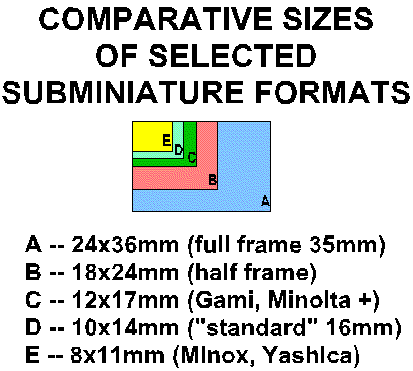


Subminiature cameras use a variety of film from 35mm on down. But, there are so many formats, one can get lost pretty easily. In addition, even with one particular brand of camera, such as Minolta, different film formats may be available -- and you may not know it!. On some cameras, the useful format size varies with the film perforations used. For example, with the Mikroma (with single perforated 16mm film) the useful negative size is 11.5x14.7mm. With double perforated 16mm film, the useful negative size is dropped to 10x14.7mm. You can use the double perf film, but the usable size is smaller, due to the sprocket holes.
Camera manufacturers complicate it by changing formats with their cameras. For example, older Minoltas, such as the 16 and 16II use a 10x14mm format on double perforated 16mm film. One their newer cameras, Minolta was able to expand the format to 12x17mm by using single perforated 16mm film. You are able to use double perforated film in the newer cameras (if you are willing to accept the smaller usable negative size) or use the single perforated film in the older cameras (knowing that the format size will not increase). So just because you've always used a particular film with your camera does not mean that that is the ONLY format that will work with your camera.
Be careful when changing formats. Some cameras need sprocket holes to advance the film, and if you move to single perf or unperforated film, it may not advance in your camera. You can usually tell by checking your camera and film spools for sprocket teeth.
There are so many submini formats that they cannot all be listed here. Please see the individual descriptions of the cameras in the CAMERA SHOP section of the SUBCLUB for more details. But here is a summay of the various formats and the major cameras that used them. At the top of the page is a visual comparison of the most popular submini formats:
24x36mm -- standard 35mm format. Sometimes called the miniature format.
16.7x30.2mm -- the new APS format
18x24mm, 17x24mm, 18x23mm -- referred to as Half-frame or Single-frame this
format was 1/2 the size of the 35mm format and used by Olympus, Yashica,
Fuji, Riccoh and many others.
14x21mm -- Tessina cameras
18x28mm -- Expo Police camera
16x22mm -- Expo watch camera
13x17 -- Used by all 110 cameras sold by Kodak, Minolta and many others.
It's also the size of Kiev and Vega Russian 16mm cameras

12x17mm -- USed by the GaMi, Minolta MGs and QT cameras
11.5x14.7mm -- Mikroma cameras
14x14mm -- numerous 17.5mm cameras
10x14mm -- This is referred to as the standard 16mm format and was used by
numerous cameras
10x10mm -- used in several 16mm cameras
8x11mm -- Used by Minox and others using the Minox cassette
8x10mm -- USed by the Kodak disc and others
6x6mm -- Echo 8 cameras
16x16mm -- Robot SC
10x10mm -- Minicord and Stylophot cameras
Here's a website that offers a historical perspective on many film formats -- http://www.xs4all.nl/~wichm/filmsize.html

To return to the main index for the Sub Club click here.
COPYRIGHT @ 1995, 1996, 1997, 1998, 1999, 2000, 2001, 2002, 2003, 2004, 2005 by Joe McGloin. All Rights Reserved.